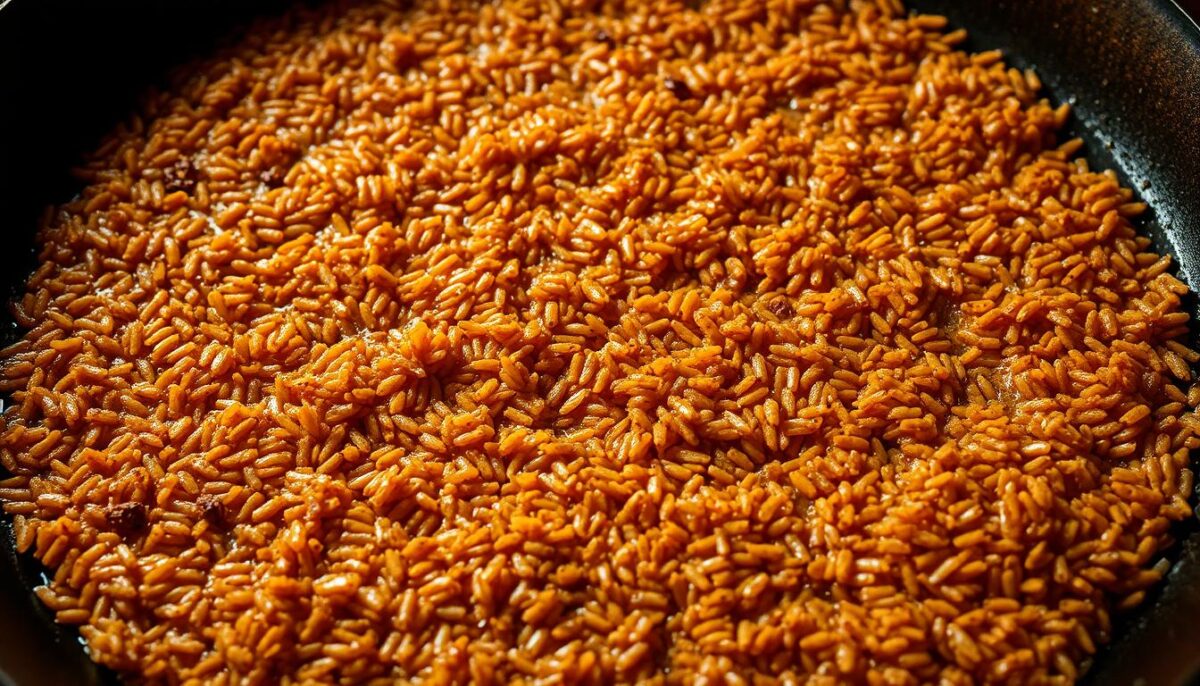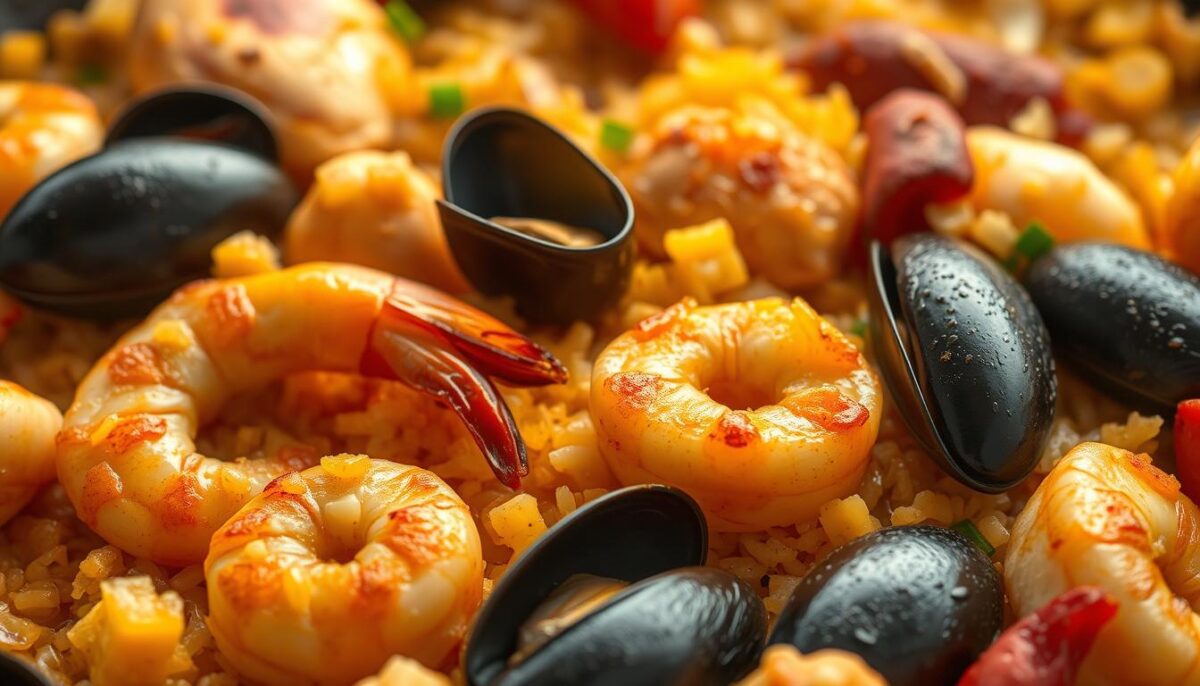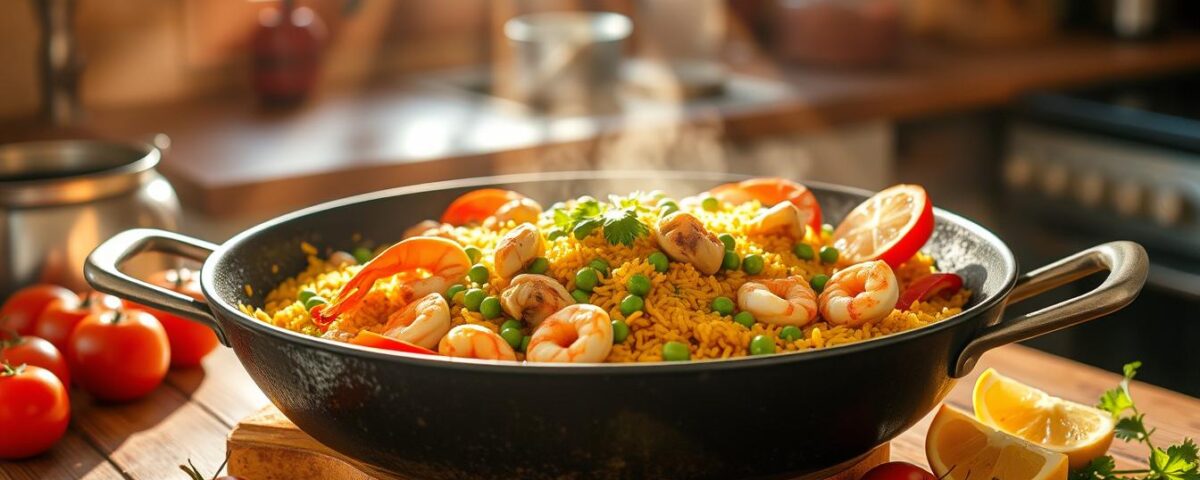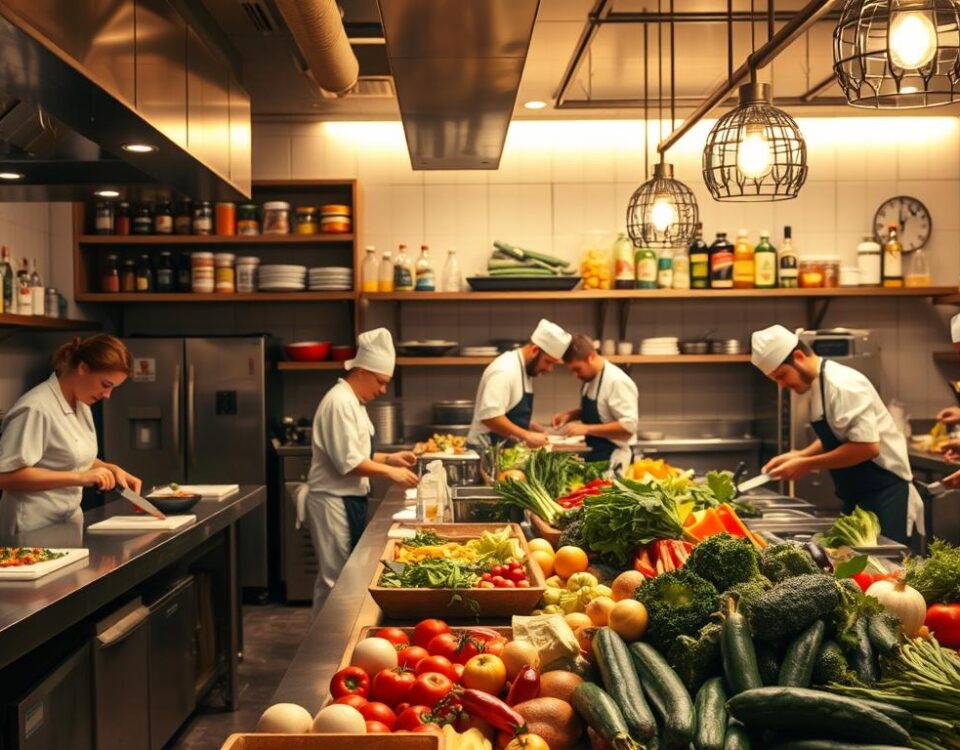
Cooking Authentic Thai Pad Thai with Fresh Ingredients
May 4, 2025
Creating Flavor-Packed Indian Chicken Tikka Masala at Home
May 6, 2025I’ll never forget the first time I tasted golden, aromatic rice simmered in broth, infused with smoky paprika and floral saffron. It wasn’t in a bustling Valencian market—it was at my tiny apartment stove, where I’d spent hours chasing that elusive balance of textures and flavors. Like many home cooks, I thought mastering this iconic dish required a pilgrimage to Spain. Turns out, all it takes is a little patience and the right guidance.
My breakthrough came during a rainy weekend experiment. I’d skipped the fancy equipment, using my trusty skillet instead of a specialized pan. The rice stuck slightly at first, but when I trusted the process—no stirring, just gentle shaking—the socarrat (that coveted crispy bottom layer) formed perfectly. That moment taught me: tradition isn’t about tools, but technique.
What makes this dish sing? Three pillars: short-grain rice that absorbs flavors like a canvas, saffron threads that paint every grain golden, and a cooking method that honors simplicity. I’ve since learned to adapt based on what’s in my pantry—seafood one week, chicken the next—while keeping its soul intact.
Key Takeaways
- No international travel required to create a memorable version of this classic dish
- Saffron quality directly impacts both color and depth of flavor
- Bomba or Calasparra rice varieties yield optimal texture
- A wide, shallow skillet can substitute for traditional cookware
- Recipe flexibility allows for seasonal ingredients without compromising authenticity
- Step-by-step guidance eliminates guesswork for first-time makers
Introduction: Savoring Spain at Home
My kitchen smelled like a Madrid mercado that rainy autumn evening. An abuela I’d met at a neighborhood mercado taught me her rhythm—swirling oil in wide circles until it shimmered, then dancing garlic through the heat. “Cariño,” she’d say, “good food needs two things: fire and patience.”
From Market Stalls to My Stovetop
Local cooks showed me how timing transforms ingredients. Three minutes to toast paprika without burning. Five cups of broth for every two of rice. Their tricks became my compass. I learned why smoked paprika outshines regular—it adds depth without overpowering saffron’s whisper.
Weeknight dinners turned into flavor experiments. I’d adjust heat levels like a DJ mixing tracks—low for sofrito, high for socarrat. The garlic? Always sliced thin, never minced. “Gold isn’t rushed,” my mentor reminded me as we stirred.
Want that same magic? Start with cold-pressed oil and watch it ripple before adding aromatics. Measure your broth like it’s precious—too little dries the rice, too much drowns the spices. Trust the clock: 18 minutes uncovered, then rest. Your fork will find crispy edges and tender centers in every bite.
My Spanish paella authentic recipe
The secret to nailing this dish? Treat every component like a soloist in a symphony. During my time in coastal towns, I learned that precise prep work separates good meals from unforgettable ones. Let me walk you through my method, honed through countless sunsets over Mediterranean kitchens.

Start with quality olive oil—about ¼ cup shimmering in your pan. Brown bone-in chicken thighs first; their fat renders magic into the base. While they sizzle, prep your mise en place:
| Traditional Approach | Modern Adaptation |
|---|---|
| Saffron threads | Smoked paprika (1 tsp) |
| Fresh rabbit | Chicken thighs (6 pieces) |
| Flat green beans | Bell peppers (2 diced) |
| Bomba rice | Arborio rice (2 cups) |
Three cloves of garlic, thinly sliced, bloom in the oil after removing the chicken. This builds layers without bitterness. Once golden, add tomatoes and let them collapse into a rustic sofrito. Here’s the kicker: measure and set aside your broth mixture (saffron steeped in 4 cups stock) before starting. No scrambling mid-cook.
Why fuss over prep? Because great results come from letting each ingredient shine. I’ve tested dozens of recipes, but this balance of smoky, savory, and bright always wins. Trust me—when you set aside prepped items, you’re not just organizing. You’re composing flavors.
Last tip: Use that reserved broth like liquid gold. Pour it in all at once after adding rice, then walk away. Twenty minutes later, you’ll uncover a crusty-bottomed masterpiece. Even my Valencian friends nod approvingly at this method.
Ingredients and Equipment Essentials
Gathering the right components transforms this iconic meal from ordinary to extraordinary. During my early attempts, I learned that each element plays a crucial role in building depth and texture. Let’s break down what truly matters in your kitchen setup.
Hand-Picked Ingredients: Saffron, Vegetables, and Meat
Saffron remains non-negotiable—its earthy aroma lifts every grain. I once used inferior threads and watched the dish turn muddy. For vibrant color, steep ¼ teaspoon in broth before cooking.
Fresh vegetables add brightness. Dice 1 cup bell peppers and ½ cup tomatoes for sweetness. When selecting proteins, bone-in chicken thighs create rich fond, while wild-caught shrimp (peeled or unpeeled) offer briny pops. Rabbit? It’s bolder than poultry but requires longer cooking time.
| Essential Components | Measurement Tips |
|---|---|
| Saffron threads | 1/4 tsp per 4 cups broth |
| Bell peppers | 1 cup diced |
| Shrimp | 6-8 large, deveined |
| Salt | 1 tsp per layer |
Choosing the Right Pan: Paella Pan vs. Skillet
Traditional pans distribute heat evenly but demand storage space. My 12-inch skillet works beautifully—just ensure it’s oven-safe. Here’s how they compare:
| Feature | Paella Pan | Skillet |
|---|---|---|
| Material | Carbon steel | Cast iron |
| Heat Control | Rapid response | Retains heat |
| Best For | Outdoor cooking | Stovetop-to-oven |
Season either with olive oil after each use. Remember: shallow sides promote evaporation, creating that crave-worthy crust. Whether using rabbit or shrimp, precise salt distribution—layer by layer—prevents bland bites.
Step-by-Step Cooking Process
Mastering this dish hinges on two transformative stages: building flavor foundations and nurturing them to perfection. Let me share how I turned countless trial runs into a reliable roadmap.

Creating the Perfect Sofrito Base
Heat 3 tablespoons of olive oil in your pan over medium-high heat. When it shimmers, add 1 diced onion and 4 minced garlic cloves. Stir until golden—about 90 seconds. This unlocks their sweetness without bitterness.
Next, stir in 2 grated tomatoes (seeds removed). Let them cook down into a thick paste, stirring occasionally. Here’s my trick: add ½ teaspoon smoked paprika after the tomatoes reduce. This prevents burning while amplifying depth.
| Traditional Sofrito | Modern Twist |
|---|---|
| Fresh tomatoes | San Marzano canned (½ cup) |
| Manual stirring | Wooden spatula scraping |
| 30-minute simmer | 15-minute concentrated cook |
Building Flavor with Broth, Rice, and Seasonings
Pour in 4 cups broth mixed with saffron. Make sure it’s warm—cold liquid shocks the rice. Add 2 cups arborio, spreading it evenly. Let grains toast for 1 minute, absorbing the sofrito’s essence.
Once bubbles form at the edges, bring to a boil for exactly 2 minutes. Then reduce to low—no peeking! This slow absorption creates tender grains with crispy undertones. I set a timer for 18 minutes, resisting the urge to stir.
Final pro tip: After removing from heat, let it rest 5 minutes. This allows flavors to marry while the crust firms up. Your patience rewards every forkful.
Choosing the Right Rice and Achieving Socarrat
My quest for the perfect crust began with a pot of mushy grains. Through trial and error, I discovered rice behaves like a sponge—some varieties absorb broth greedily, others hold their shape. The magic happens when you pair the right grain with precise heat control.

Selecting Rice Varieties and Substitutions
Bomba rice remains the gold standard. Its pearly grains expand widthwise rather than lengthwise, creating distinct texture. When unavailable, arborio works—just reduce water by ¼ cup to prevent sogginess. I once used sushi rice in a pinch; rinsing it thoroughly prevented stickiness.
Fresh tomatoes matter more than you’d think. Their acidity balances rich seafood or meats. Grate them into your sofrito, skins discarded. For extra brightness, add a pinch of pepper during this stage—it awakens the tomatoes’ natural sweetness.
Secrets to Forming a Crispy, Flavorful Bottom Layer
Socarrat isn’t an accident—it’s science. After adding rice, resist stirring. Let flames lick the pan’s center while rotating it occasionally. When you hear faint crackling (around minute 16), lower the heat. The grains will caramelize without burning.
Finish with a sprinkle of parsley and lemon zest. These aren’t just garnishes—their freshness cuts through richness. My mentor taught me: “Season in layers, taste as you go, and let the pan do its work.” That crisp golden layer? It’s your reward for patience.
Adaptations and Personal Cooking Tips
Experimentation became my compass in the kitchen. One summer evening, I swapped chicken for plump mussels and discovered how seafood transforms the food into something coastal and vibrant. That’s the beauty of this dish—it’s a canvas for creativity.

Protein Play and Pantry Freedom
Meat choices shape the character of your meal. Try spicy chorizo for smoky depth or turkey for leaner options. Vegetarian? Roasted artichokes add earthy notes. I once used leftover pork ribs—their rendered fat created an unforgettable richness.
Bell peppers offer color flexibility. In winter, use roasted red ones from jars. Summer calls for fresh green varieties. Mix them for visual appeal. Always slice thin—they should complement, not dominate.
Distribution matters. Arrange proteins and veggies evenly across the top layer. Pour liquid gently to avoid displacing ingredients. This ensures every spoonful delivers balanced flavors.
| Ingredient Swap | Flavor Impact |
|---|---|
| Mussels + clams | Briny, oceanic |
| Chickpeas + zucchini | Hearty, vegetarian |
| Duck + cherries | Rich, sweet-savory |
Control fat by blotting meats before cooking. A light hand with oil keeps textures crisp. Remember: tradition guides, but your palate leads. As my Valencian friend says, “The best version is the one you’ll make again.”
Conclusion
Creating memorable meals at home comes down to balancing technique and intuition. Through countless trials, I’ve learned that achieving that crispy bottom layer—the socarrat—is less about strict rules and more about trusting your senses. Let the rice sizzle just until you smell toasted notes, then pull back the heat. That golden crust becomes your edible trophy.
For best results, stick with bomba rice if possible. Its unique absorption creates ideal texture. Serve directly from the pan, allowing 2-3 servings per person. Top with lemon wedges and parsley for freshness that cuts through rich flavors.
My instructions simplify the process, but don’t hesitate to experiment. Swap proteins or veggies based on what’s seasonal. The true magic lies in layering flavors patiently. Need more guidance? Explore our links for pairing ideas and advanced techniques.
Thank you for letting me share this journey. Now it’s your turn—grab that skillet, embrace the sizzle, and tell me about your first socarrat triumph. Every crispy bite proves home kitchens can rival coastal eateries.
FAQ
Can I use a regular skillet if I don’t own a paella pan?
Yes! While a traditional pan’s wide surface helps cook rice evenly, a large, shallow skillet works. Just ensure it’s oven-safe if finishing under broiler heat.
What’s the best rice substitute if I can’t find Bomba or Calasparra?
I’ve had success with Arborio (used in risotto) because it absorbs liquid well. Avoid long-grain types—they won’t give that creamy-yet-firm texture we love.
How do I get the crispy bottom layer without burning the dish?
Listen for crackling sounds and check the edges. Once liquid evaporates, lower the heat slightly. A golden socarrat forms in 1-2 minutes—patience is key!
Can I skip saffron? It’s pricey!
Saffron adds that iconic golden hue and earthy flavor. For a budget swap, use ½ tsp turmeric + ¼ tsp smoked paprika, but expect a slight taste shift.
What proteins work besides chicken and shrimp?
I’ve tried rabbit, duck, or even firm tofu. Mussels and clams add briny depth. Mix and match, but brown meats first for richer flavor.
Why does my rice turn mushy?
Over-stirring breaks the grains. Spread rice evenly once added, then resist the urge to mix. Let the broth do its magic undisturbed.
Can I make a vegetarian version?
Absolutely! Swap meat for artichokes, butter beans, and roasted peppers. Use veggie broth and add a splash of white wine for acidity.
How do I store leftovers?
Keep it in an airtight container for up to 3 days. Reheat gently in a pan with a splash of broth to revive the texture.



